Rangiri Dambulla Cave Temple
By Lisa
What is Rangiri Dambulla Cave Temple?
Dambulla Cave Temple is one of eight UNESCO World Heritage sites located in Sri Lanka. It is the largest and best-preserved cave temple complex in the country. The site has over 80 documented caves, five of which make up the Rangiri Dambulla Cave Temple and contain statues and paintings depicting the life of Gautama Buddha.
Disclosure: This article contains affiliate links. Making a purchase through an affiliate link will mean a small commission for this website. This will not affect your price.
Among the 153 Buddha statues, there are also statues of Sri Lankan kings and gods like Vishnu and Ganesha. The extensive and beautifully-preserved murals depict significant events such as the temptation by the demon Mara and Buddha’s first sermon. They cover an impressive 2,100 square meters (22,600 square feet).

A note for clarity: Dambulla Cave Temple and Dambulla Rock Temple are two different names for exactly the same place. The temple complex consists of five separate caves and the Dambulla Golden Temple. At the bottom of the hill is the Golden Temple, close to the main road. At the top of the hill is the Cave Temple. Realistically, you should go ahead and visit the Golden Temple and the Cave Temples at the same time since they are basically right next to each other.
Why is Rangiri Dambulla Cave Temple a UNESCO World Heritage site?
It’s pretty clear why this place has been designated as a UNESCO World Heritage site. It is an amazing example of cave temple architecture with outstanding cultural and historical significance. The site is renowned for its well-preserved cave paintings and statues, particularly those related to Gautama Buddha and his life. They are an ‘outstanding example of the religious art and expression of Sri Lanka and South and Southeast Asia,’ according to UNESCO, ‘…unique in scale and degree of preservation.’
Additionally, the site has been a place of pilgrimage for over 2000 years. ‘The site is remarkable in the Buddhist world for its association with the continuous tradition of living Buddhist ritual practices and pilgrimage for more than two millennia’.

What can you expect on a visit to Dambulla Cave Temple?
Firstly, these caves are probably much smaller than you are imagining. They are more like an open space under a hanging rock. What makes these extra impressive is that they are not natural caves, but carved out by hand by the monks.
There are two paths up to the caves, one steeper than the other. We walked up with young kids and it was perfectly doable. It can get busy in there but consider your time and you might manage to avoid the crowds. When you arrive, you will need to remove your shoes and pay to store them. There are five caves in all. The first one is tiny so some patience (and queuing) is needed. The second one is huge and the third is pretty big too. The other caves are pretty similar.
We started visiting the ‘caves’ from the one furthest from the entrance building to the biggest and most elaborate.

- Cave 5: The Great Western Monastery is the smallest, and is believed to have been the dwelling place for meditating monks.
- Cave 4: The Second New Temple has a seated Buddha statue and a few smaller statues of other deities.
- Cave 3: The Great New Temple is filled with several smaller Buddha statues and simple paintings and frescoes.
- Cave 2: The Cave of the Great Kings houses a large standing Buddha that is approximately 7 meters (22.9 ft) tall.
- Cave 1: The Cave of the Divine King is the largest and most elaborate cave in the complex. It has a 14-meter-long (46 ft) reclining Buddha statue.
Don’t forget to look up as you wander around inside the temples; the ceiling frescoes are impressive (maybe more so than the Buddha statues themselves). The ceilings are uneven but with the decoration, it almost looks as though it is a giant piece of colourful fabric, but these are painted frescoes.
When at the top, the path to the left on the way down leads you to the Golden Temple, with its giant Budda, which is also worth seeing.
Take a full-day private tour of Sigiriya and Dambulla Caves from Kandy or a full-day group tour from Colombo.
Is Dambulla Cave Temple worth visiting?
The Dambulla Cave Temples are said to date back to the first century BC. Buddhist monks first hand-carved the caves. They are well preserved and still functioning today after nearly two thousand years of continual use. They may not be impressive in terms of size and grandeur but this is one of the best-preserved antiquities you’ll ever visit.
Most visits will only take 1-2 hours. It’s not a very big complex and is a great place to add onto your travels around the area.
Anyone interested in Buddhism and its history or Buddhist art will find this site interesting.
Book your accommodations in Kandy here.

Tips for visiting Dambulla Cave Temple
Similar to most Buddhist temples in Southeast Asia, you can’t wear shorts and women need to cover their shoulders. Dress respectfully.
Also, most importantly, don’t pose for pictures with your back to Buddha!
The site isn’t accessibility friendly; it requires some walking to get to the top.
Buy tickets at the Lower / South Entrance. There are three entrances to the temple complex, but only one ticket counter. If you enter through the Golden Temple or the local entrance halfway down the hill, you will have to walk downhill to the temple counter. There is no way to buy tickets at the top where they collect them.
You may find it useful to bring a torch because some of the temples are pretty dark inside.
There are no services at the top. Take water and make sure you use the bathroom before you head up. On the way down to the Golden Temple there are local sellers with some snacks available. Very close by, a troop of monkeys waits to steal your snacks from you. Be warned: they can be persistent and aggressive.
Whilst Dambulla is a fantastic site to visit, combine it with a trip from Sigiriya or visit from Kaudulla National Park after a safari. It’s a good place to stop en route to Kandy too.
Where is Rangiri Dambulla Cave Temple?
You’ll find the Dambulla Cave Temple in the city of Dambulla. Dambulla is located 160 km (99 mi) from Colombo, 105 km (65 mi) from Trincomalee, or 73 km (45 mi) from Kandy, Sri Lanka, which is another UNESCO site.
We traveled to Dambulla Cave Temple from Sigiriya, also a UNESCO site. Take a tuk tuk return or a tuk tuk to Dambulla and a short bus ride. (Negotiate a return tuk tuk and your driver will wait to take you back.) If you’re catching a bus, you’ll want one heading in the direction of Colombo Fort.
Rangiri Dambulla Cave Temple is open from 7am-7pm every day with the ticket office closing at 5pm.
For more information about Rangiri Dambulla Cave Temple, its opening hours and admission fees, see the Sri Lanka tourism website.
Have you been to Dambulla Cave Temple? If so, do you have any additional information or advice about this UNESCO World Heritage site? Please add your comments below!

